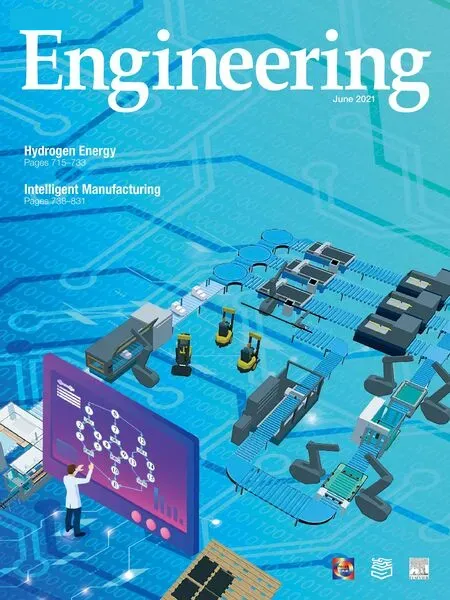Comparison of Production-Triggering Strategies for Manufacturing Enterprises under Random Orders
Longfei Zhou, Lin Zhng*, Yjun Fng
a Computer Science and Artificial Intelligence Laboratory, Massachusetts Institute of Technology, Cambridge, MA 02139, USA
b School of Automation Science and Electrical Engineering, Beihang University, Beijing 100191, China
Keywords:
ABSTRACT Although new technologies have been deeply applied in manufacturing systems, manufacturing enterprises are still encountering difficulties in maintaining efficient and flexible production due to the random arrivals of diverse customer requirements. Fast order delivery and low inventory cost are fundamentally contradictory to each other. How to make a suitable production-triggering strategy is a critical issue for an enterprise to maintain a high level of competitiveness in a dynamic environment.In this paper, we focus on production-triggering strategies for manufacturing enterprises to satisfy randomly arriving orders and reduce inventory costs. Unified theoretical models and simulation models of different production strategies are proposed, including time-triggered strategies, event-triggered strategies, and hybrid-triggered strategies. In each model, both part-production-triggering strategies and product-assembly-triggering strategies are considered and implemented. The time-triggered models and hybrid-triggered models also consider the impact of the period on system performance. The results show that hybrid-triggered and time-triggered strategies yield faster order delivery and lower inventory costs than event-triggered strategies if the period is set appropriately.
1. Introduction
The rapid development of sensor technologies and the Internet of Things enables manufacturing enterprises to perceive manufacturing resources and abilities more precisely by synchronizing their resource statuses with the data in their enterprise information systems [1–3]. From a global perspective, cloud-based technologies allow closer connections and easier collaborations between different manufacturing enterprises. Some cloud manufacturing service platforms have already been established to integrate and share the manufacturing resources from different enterprises in the form of manufacturing services [3]. Through these public platforms, enterprises are able to publish real-time information of their manufacturing resources and provide services as required by customers [4]. Meanwhile, more diverse customer requirements are collected on these platforms, which makes it more difficult for enterprises to create production plans to satisfy their diverse customers.
The relationship between enterprises and customers is defined as the relationship between service providers and service demanders in a manufacturing service network consisting of a platform,a platform manager, service providers, and service demanders[5]. Any enterprises or individuals can be service demanders on the platform,as long as they are seeking suitable services to realize their manufacturing requirements. A company can become a service provider if its resources or services are allowed to be published on the platform and shared with other potential service demanders. The service manager on the platform is usually a big company that manages all the businesses on the whole platform.The service manager usually cares more about the outcomes and efficiency of the whole platform than about the production performance of a single company,whereas a single company cares more about its own production.The efficiency of the whole platform can often be measured by statistical metrics such as average production time,average service utilization rate,and average manufacturing costs.
Some studies have focused on global optimization problems in a collaborative manufacturing service network, including service selection, service composition, and service scheduling problems in which optimization objectives, algorithms, and restrictions are considered[6].To organize and optimize manufacturing resources,a resource-selection strategy based on a distributed genetic algorithm has been proposed [7]. For three-dimensional (3D) printing services, a matching and selection strategy has been presented based on different attributes of 3D printing models in order to achieve a shorter service time [8]. A systematic method has been proposed to improve the energy efficiency of a multistage manufacturing system through production control [9]. In Ref. [10], a mathematical model and a method for logistics service selection were built to optimize the delivery time of products from manufacturers to demanders.Furthermore,a multi-level aggregate serviceplanning method has been proposed to deal with multi-granularity services and meet providers’requirements[11].In terms of service composition,Ref.[12]proposed a resource-service chain composition algorithm to cope with the temporal relationship.In Ref.[13],an empirical knowledge-oriented genetic algorithm is proposed to address the optimal service composition problem.The artificial bee colony algorithm was modified to handle conflicts between different objectives in service composition problems [14]. In terms of service scheduling, a scheduling method for 3D printing services was proposed in order to reduce the average task delivery time[15].A multi-task scheduling model was presented to consider task workload,service efficiency,and service quantity[16].In addition,scholars have studied the scheduling problems of logistics services[17] and dynamic service scheduling problems [18]. As real-time sensors and data assimilation technologies develop rapidly, an increasing amount of real-time data is available for discrete event simulation to achieve on-line simulation and decision-making[19,20]. A simulation model of a vehicle general assembly system was developed based on the event-scheduling simulation method[21]. The dynamic data-driven simulation method performs well in dealing with real-time manufacturing service scheduling problems[22,23].Few previous studies have explored different production strategies that allow a single enterprise to conduct suitable production planning in a collaborative manufacturing environment. However, each company always has its own goal, which is generally related to its own production performance.
For manufacturing enterprises, it is an interesting problem to determine how to maintain a balance between low inventory cost and fast order delivery.It is valuable for manufacturing enterprises to find a better balance between their production time and inventory cost. On the one hand, if an enterprise wants to produce and deliver products as soon as possible, it needs to prepare enough parts and products in advance so that randomly arriving orders can be satisfied in time. But these prepared parts and products need to be stored in the inventory for days or even months,which inevitably leads to higher inventory costs.On the other hand,if an enterprise wants to reduce its inventory costs,a possible method is to start production only after receiving certain orders from the customers. However, this strategy may result in order delivery delay,which can decrease customer satisfaction. Just-in-time (JIT) and just-in-case(JIC)inventory management are two typical inventory management strategies.The core philosophy of JIT is for manufacturers to have a suitable inventory readily available to meet the current requirements,while reducing excess and thereby avoiding extra inventory costs[24].The JIT strategy requires manufacturers to predict demand accurately in order to reduce their inventory costs as much as possible [25]. In contrast, when using JIC strategies, manufacturers make sufficient parts and products and keep them in their inventories in order to meet as many customer orders as possible at any time.Therefore,JIT aims to reduce inventory costs while JIC aims to speed up order delivery.The problem of determining the amount and time of product purchase has been considered, while minimizing the sum of the logistics cost and material inventory cost [26].
Previous studies have mainly focused on the qualitative analysis or data statistics of different production and inventory management systems. In this paper, we propose unified theoretical models and simulation models of different production strategies, including time-triggered strategies, event-triggered strategies, and hybridtriggered strategies. In addition,simulations of various production strategies are conducted based on these multiple simulation models in order to determine the impact of production-triggering strategies on inventory costs and order delivery time. More specifically, we providea mathematicalmodel of the production-triggering problem and propose multiple production-triggering strategies (i.e., timetriggered, event-triggered, and hybrid-triggered strategies). For each type of production-triggering strategy, we build the process models and run simulations to test its performance in terms of production time and inventory costs.
Let X and r represent the number of order arrivals and the arrival rate of orders during a certain time, respectively. Assume that X ~ Pois(r), which means that X obeys the Poisson distribution.The simulation results show that time-triggered strategies and hybrid-triggered strategies obtain faster order delivery time and lower inventory costs than event-triggered strategies when a suitable time period (1/r) is chosen.
The rest of this paper is organized as follows. In Section 2, we analyze the production process and provide a mathematical description of the problem. In Section 3, we propose three types of production-triggering strategies and build their simulation models.In Section 4,simulations are conducted to compare the performance of various production-triggering strategies. Finally,conclusions and further work are discussed in Section 5.
2. Problem formulation
2.1. Manufacturing service network
The relationship between service providers and service demanders in a collaborative manufacturing environment can be described through a complex network of manufacturing supply and demand.Enterprises usually act as service providers,providing multiple types of manufacturing services based on their manufacturing resources and capabilities. Manufacturing services can be described using the service granularity model to represent the different levels of manufacturing services. The simplest services are called unit services;these are always provided by single manufacturing machines or tools. Multiple-unit services can be combined to form a complex service that can execute more complex manufacturing functions.In this paper,we consider a higher-level model of manufacturing services in which enterprises are encapsulated as single services whose inputs and outputs are respectively the customers’ orders and the completed products. This paper aims to study the impact of different production strategies inside enterprises on the performance of outputs for random input situations.
On the one hand, a manufacturing service can usually execute multiple types of subtasks due to the flexibility of manufacturing services. For example, an enterprise might provide a computer numerical control(CNC)machining service,which is a very typical manufacturing service. This CNC machining service might support multiple machining tasks such as column, cone, sphere, thread,plane, groove, gear, and bore tasks. On the other hand, a specific subtask type can be executed by different manufacturing services,as different companies may compete to provide the same kind of services. Based on the above analysis, the mapping relationship between manufacturing services and subtasks is a many-to-many relationship.
There are also different kinds of uncertainties,such as randomly arriving orders and random service breakdowns. Usually, the number of order arrivals during a unit of time basically obeys the Poisson distribution, Pois(r), where r is the arrival rate of orders.When an order arrives at the manufacturing platform,it is matched to a certain type of manufacturing service in the platform according to the type of order.
Fig. 1 shows a simple collaborative manufacturing service network with two service demanders and two service providers. It can be seen that demander D1submits an order O1to the manufacturing platform,and the platform allocates this task to provider P2.Thus, a supply–demand relationship between provider P2and demander D1is built based on this match. Provider P2delivers the product of order O1to demander D1after finishing the production process of order O1.Also,demander D2submits its order O2to the platform,and the platform distributes O2to provider P1.Hence,a supply–demand relationship between provider P1and demander D2is also built through the manufacturing platform. Provider PP1delivers the product of order O2to demander D2after finishing the production process of O2.
2.2. Production processes
A production process can be briefly divided into several main steps including material input, part production, part storage,product assembly, and product storage. For an enterprise, orders from customers can be considered as the information input of the manufacturing system, while materials can be considered as the physical input. Materials come from upstream suppliers in the supply chain, while orders come from downstream customers in the supply chain.Products are the output of a manufacturing system for an enterprise.After the production process is completed,including part production and product assembly,the products are stored in the product warehouse;finally,they are delivered to customers.
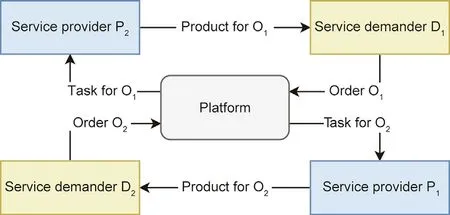
Fig. 1. A manufacturing service network with two service demanders and two service providers.
Fig. 2 briefly presents the production process of an electronic assembly manufacturing enterprise from the materials (left side)to the products (right side). There are different material pools in the material warehouse for different types of material.In the electronic assembly manufacturing industry,materials mainly include printed circuit boards and electronic components. Materials are automatically delivered to part production lines when the manufacturing system starts the production process.On the part production lines,the materials are processed into different kinds of parts.Particularly for the electronic assembly industry, electronic components are mounted on printed circuit boards through surfacemount technology lines to manufacture different types of parts.The produced parts are then transported to the part inventory for future usage.The product assembly lines take out a certain number of parts from the part inventory and assemble them into products.After being assembled, the products are stored in the product inventory. Finally, the products are delivered to customers via logistics to complete the order.
2.3. Mathematical description
Given randomly arriving orders in a dynamic environment,it is necessary to choose a certain period of time to analyze.Let tsand terepresent the start time and end time, respectively, of the whole time of duration under study. Let Oirepresent the ith arriving order,which arrives at time Ai.After order Oiarrives,the manufacturing system is triggered by a triggering strategy, and the manufacturing system immediately starts to execute the production process for Oi. The products of Oiare produced after the manufacturing system finishes its whole production process,including part production and product assembly.
2.3.1. Optimization objectives
In this research, we mainly consider two optimization objectives of this problem: the order delivery time and the inventory occupation.Let Cirepresent the completion time of order Oi; then,the optimization objective of the order delivery time can be given by Eq. (1).

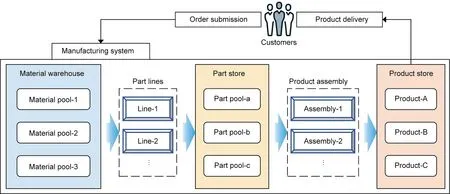
Fig. 2. The basic production process of manufacturing enterprises.
where N is the number of all arriving orders at the manufacturing system during time[ts,te),and the definition of N is given by Eq.(2).

Therefore,the optimization objective of the order delivery time can also be written as shown in Eq. (3).

The optimization objective of the inventory occupation includes both the part inventory and the product inventory. Let Ipart(t) and Iprod(t) represent the part inventory occupation and the product inventory occupation at time t,respectively.The average inventory occupation is calculated by dividing the total inventory occupation between time tsand teby (te- ts). Eqs. (4) and (5) provide the expressions for the average part inventory occupation and the average product inventory occupation, respectively.

In practice, the order delivery time and the inventory costs are contradictory to each other. It is necessary to reconcile them and find a suitable balance point for each situation.
2.3.2. Order arrival time distribution
The number of order arrivals X in each time period obeys the same Pois(r) in all simulation models. Therefore, X ~ Pois(r), as shown by Eq. (6).

where r is the arrival rate in the models,and is actually the average number of orders per time period.Let Birepresent the interval time between the arrival of Oiand the arrival of Oi-1. Then, Biis defined by Eq. (7).

where A0= 0 and i ≥1. Biobeys the same exponential distribution Exp(r)in the simulation models,which is defined as Bi~Exp(r).The cumulative distribution function of Biis given by Eq. (8).

Fig. 3 shows the detailed structure of the arrival time function block. The input and output of the arrival time function are the arrival rate and the arrival time, respectively. Each order arrival triggers the arrival time function;then the model obtains the arrival time of this order.In the simulations,we set the arrival rate r as 0.5 in multiple simulation models. When we run the simulations,orders from customers are generated randomly based on the arrival time function.
3. Production-triggering strategies
In a manufacturing service network, service providers need to dynamically adjust their production strategies according to system statuses such as order arrivals and service availability. A production-triggering strategy is one of the most important production strategies for a manufacturing enterprise. In this section,three types of production-triggering strategies are presented:time-triggered, event-triggered, and hybrid-triggered strategies.Let Tpart(i) represent the triggering time of the ith part, and use Tprod(j) to represent the triggering time of the jth product. A production-triggering strategy can therefore be fully defined by Tpart(i) and Tprod(j).
3.1. Time-triggered strategies
In mass-production mode, companies usually produce batches of parts and products periodically, according to production plans.Mass-production mode is a kind of time-triggered production strategy.In time-triggered production strategies,both the part production and the product-assembly process are periodically triggered by a certain time. In a time-triggered model, enterprises execute production according to a specific time period and do not consider order arrivals.Let τpartand τprodrepresent the triggering period of part production and the triggering period of product assembly, respectively. Time-triggered strategies are defined by the part-triggering time Tpart(i) and the product triggering time Tprod(i), which are shown by Eqs. (9) and (10).

Fig. 4 illustrates a model of a time-triggered production strategy.At the beginning of the left side of the figure,there is a part trigger that triggers part production lines to execute the part production process. After parts have been completed by the part production lines, they are transported to the part store. The part store is followed by product assembly lines,which execute product assembly processes after every time period. After products are assembled by the product assembly lines, they are stored in the product store. Once there is a product matching an order in the product store, the matched product will be delivered to the customer for that order. The product delivery part executes the order-matching process and the product delivery process.
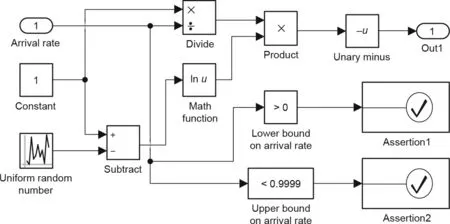
Fig. 3. The arrival time function block in the simulation models.
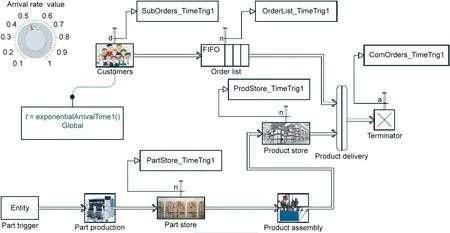
Fig. 4. A model of a time-triggered production strategy. FIFO: first in first out; n: number; d: departure; a: arrival.
It can be seen that part production and product assembly are both triggered by a certain time period in a time-triggered production model, and do not depend on order situations. The part production lines produce a certain number of different types of parts during each time period.Each batch of parts is immediately deposited into the part warehouse after being completed. The product assembly lines also produce a certain number of products during each time period.The completed products are immediately deposited into product warehouses.
Note that the time periods of part production and product assembly are usually different from each other, even within the same enterprise. These two time periods are usually related to the specific industries,product types,and production beats.In this model, products are delivered from product warehouses to customers when orders are received.If there are not enough products for one order,delivery services will wait until enough products are produced.Therefore,the production processes are not impacted by order arrivals. The production processes continue according to a certain time period, even when there are enough products stored in the warehouses; they will not speed up, even when there are not enough products in the warehouses.
3.2. Event-triggered strategies
In the personalized customized production mode, enterprises set up their production plans normally, based on event-triggered strategies;that is,the product scales and types are based on orders received from customers. In event-triggered production modes,part production processes are triggered by order arrivals. Let Tpart(i) represent the part-triggering time, as shown in Eq. (11).

The product assembly process of order Oiis triggered only if at least one of the product assembly lines is available and there are no other parts ahead of Oiin the part inventory.Let Spart(i)and Sprod(i)represent the part production time and product assembly time of Oi, respectively.
When i=1,the triggering time of product assembly for O1is the arrival time of O1plus the part production time Spart(1), which is defined by Eq. (12).

When i ≥2,the triggering time Tprod(i)of the product assembly for Oiis defined in a recursive function, which is defined by Eqs.(13), (14), and (15).

A model of an event-triggered production strategy is shown in Fig. 5. Unlike time-triggered production strategies, both the part production activities and the product assembly activities are triggered by specific events in an event-triggered production model.In particular, when an order arrives, a production plan for both the part production and product assembly is developed, based on the type and quantity of the order.Then part production lines start to produce corresponding parts according to the production plan.After the parts have been completed by the part production lines,they are transported to the part store. The part store is followed by the product assembly lines, which execute product assembly processes. After the products have been assembled by the product assembly lines,they are stored in the product store.Once there is a product matching an order in the product store, the matched product will be delivered to the customer for that order. The product delivery part executes the order-matching process and the product delivery process. It can be seen that warehouses in the eventtriggered model are always used to temporarily store parts and products.Once the product assembly line receives the part,assembly begins. Each product will be delivered to its customer through logistics once it has arrived at the product warehouses.
3.3. Hybrid-triggered strategies
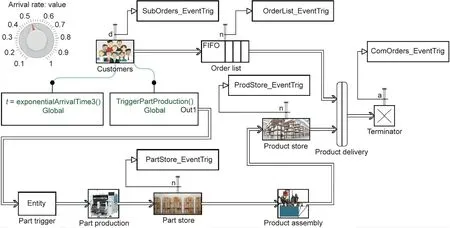
Fig. 5. A model of an event-triggered production strategy.
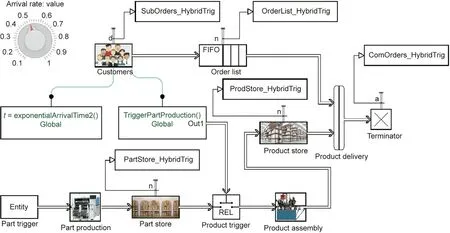
Fig. 6. A model of a hybrid-triggered production strategy. REL: release.

A production model of hybrid-triggered production strategies is shown in Fig. 6. Unlike time-triggered production strategies and event-triggered production strategies, the part production processes in a hybrid-triggered production model are time-triggered,while the product assembly processes are event-triggered. In this model,the part production lines produce certain numbers of parts during each time period.The time period of part production is represented by Tpart(i), as shown in Eq. (16).

Each batch of parts is stored in the part warehouses after being produced. Product assembly lines are triggered only by arriving orders from customers.When an order arrives,the product assembly lines request the needed parts and start production if there are enough parts in the part store to produce the required products.If there are not enough parts, the product assembly lines will wait until enough parts have been produced by the part production lines. In a hybrid-triggered strategy, the triggering time Tprod(i) of the product assembly for Oiis defined by Eq. (17), below, where α and β are defined by Eqs. (14) and (15), respectively.
In the hybrid-triggered model, order arrivals do not impact the part production processes but do impact the product assembly processes. Product warehouses in the hybrid-triggered model are used to temporarily store products because all stored products are immediately delivered from the warehouses to the customers once they have been produced.
4. Simulation
To test the performance of these proposed strategies,we design different simulation experiments and investigate the impact of production-triggering strategies on the production performance under randomly arriving orders. We build simulation models for different triggering strategies and then run multiple simulations through SimEvents.
4.1. Scenarios
In this case study, there are five enterprises acting as different service providers in the manufacturing service network. We build five models for these five enterprises in order to run simulations.The simulation time for each model is set up to 1000 time periods.Some basic modules—such as part trigger, part production, part store, product assembly, product store, customers, order list, and product delivery—are included in each simulation model. The order arrival rates, part triggers, and product triggers for all simulation models are listed in Table 1.
It is shown that Model-1, Model-2, and Model-3 are time triggered. However, the time periods of Model-1, Model-2, and Model-3 are different from each other,which is used to investigate the effect of time periods on production performance. Model-4 is hybrid triggered: The part production lines are triggered by time with a period of 2, while the product assembly lines are triggered by arrival orders. Model-5 is event triggered, so both the part production lines and the product assembly lines are triggered by arrival orders. There are two kinds of triggers in these simulation models: part triggers and product triggers. The part trigger is applied in the event-triggered model (Model-5), and the product trigger is applied in the hybrid-triggered model(Model-4).Product inventory capacities are set to 100 for all five production models.Part inventory capacities are set to ‘‘inf” (i.e., infinite) for all five production models.The number of arrival orders during the simulation is shown in Fig. 7.
4.2. Results
During the simulation, we count several kinds of data for each production model in order to compare the task delivery and inventory costs between different strategies. In terms of task delivery,we compare two indicators between these five production models:the number of orders in the waiting lists and the number of completed orders. In terms of inventory costs, we compare both the number of parts in the store and the number of products in the store between these five production models. Therefore, between the different production-triggering strategies, we compare four aspects: the number of orders in the waiting lists, the number of completed orders, the number of parts in the store, and the number of products in the store. The definitions of these evaluation metrics are given below:
The number of orders in the waiting list is the number of orders in the order list in Figs. 4–6. The number of orders in the waiting list is actually the number of input orders(i.e.,the number of arriving orders submitted by customers) minus the number of completed orders (i.e., the number of completed products).
The number of completed orders is the number of all orders that have been completed and delivered to the customers.This value is actually equal to the number of inputs of the terminator in Figs. 4–6. One order is considered to be completed only after a finished product has been matched with this order.
The number of parts in the store is the number of parts in the part store in Figs. 4–6 at the current time. The number of parts in the store is equal to the number of produced parts from the partproduction lines minus the number of parts used for product assembly.

Table 1 Parameter setting of the simulation models.
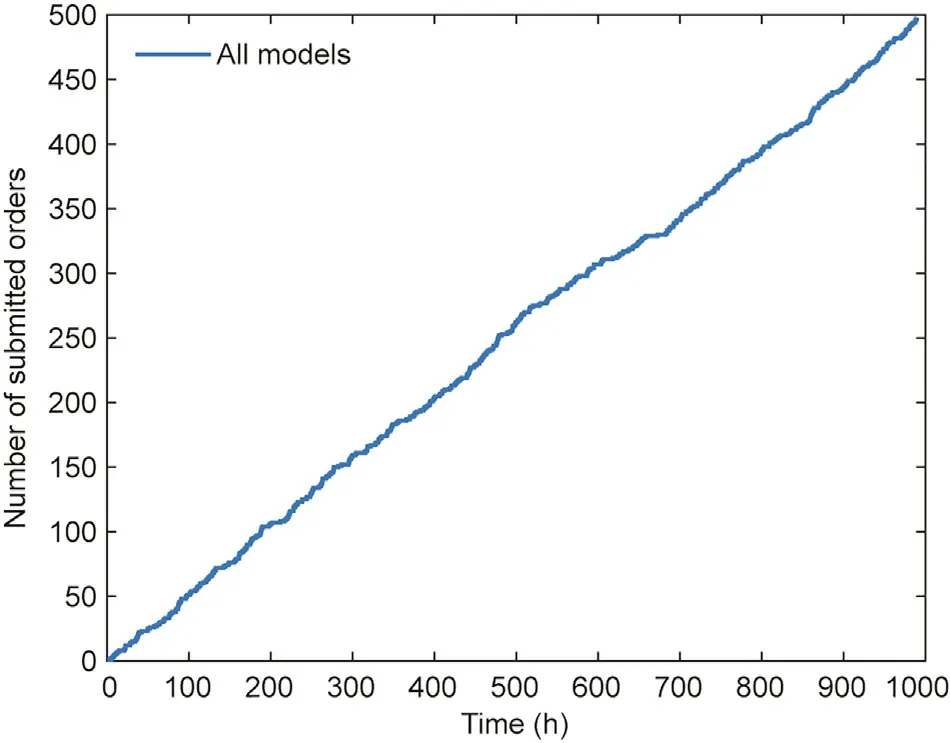
Fig. 7. The number of submitted orders during the simulation.
The number of products in the store is the number of products in the product store in Figs.4–6 at the current time.The number of products in the store is equal to the number of assembled products from the product production lines minus the number of products delivered to the customers according to orders.
Fig. 8 shows a comparison of the results for the number of orders in the waiting lists over time between the five production-triggering models. It is shown that the numbers of orders in the waiting lists in the time-triggered (period = 1, period = 2) models and the hybrid-triggered model change much less than those in the time-triggered(period=3)model and the eventtriggered model during the simulation. The numbers of orders in the waiting lists in the time-triggered (period = 3) model and the event-triggered model reach 170 and 90, respectively, by the end of the simulation time (te= 1000 h). This result indicates that the numbers of orders in the waiting lists in the time-triggered (period = 1, period = 2) models and the hybrid-triggered model are convergent when the time is over, while those of the timetriggered (period = 3) model and the event-triggered model are not convergent.

Fig. 8. A comparison of the numbers of orders in waiting lists between different productions modes.
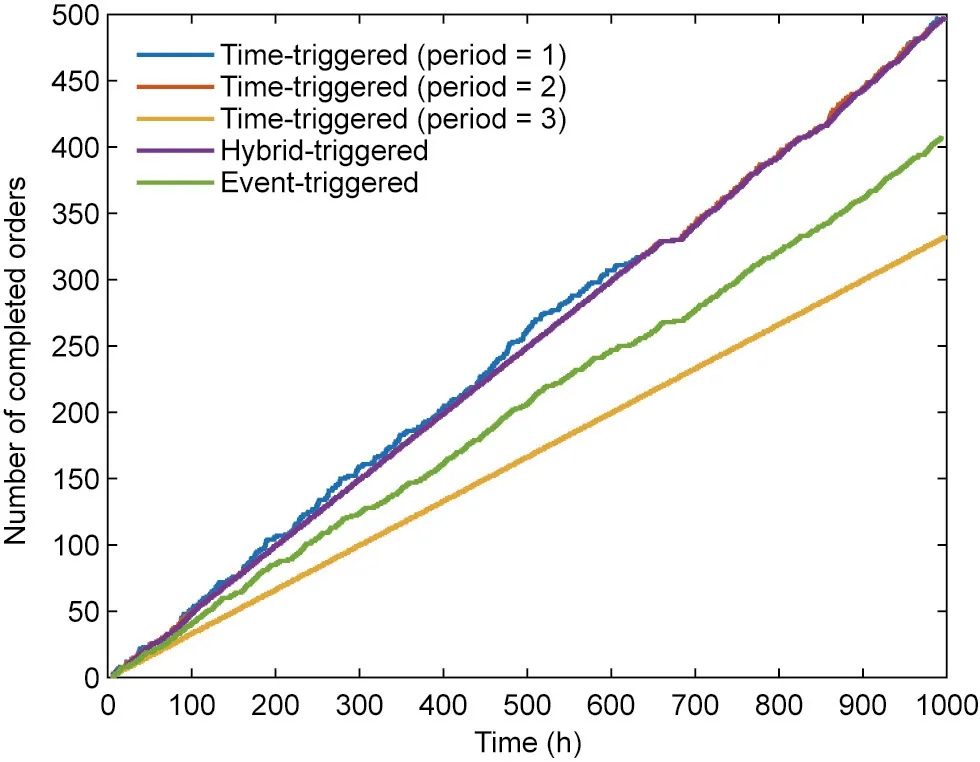
Fig. 9. A comparison of the numbers of completed orders between different production modes.
Fig.9 shows a comparison of the results for the number of completed orders over time between the five production-triggering models.It is shown that the number of completed orders in all five production models increases continually from the beginning(ts= 0 h) to the end (te= 1000 h) of the whole simulation process.In terms of the number of completed orders, the shorter period time-triggered models (i.e., period = 1 and period = 2) and the hybrid-triggered model perform almost the same during the whole process.Sometimes(between t=500 h and t=600 h),the shortest time-triggered model(period=1)performs a little better than the time-triggered model(period=2)and the hybrid-triggered model.Both the longer period time-triggered model (period = 3) and the event-triggered model perform worse than the shorter period time-triggered models (period = 1, period = 2) and the hybridtriggered model in terms of the numbers of completed orders.
Fig. 10 shows a comparison of the results for the number of parts in the inventory over time between the five productiontriggering models. It is shown that the numbers of parts in the inventory of all five models are almost always close to 0 from the beginning time (ts= 0 h) to time 600 (t = 600 h). From time 600(t=600 h)to the end time(te=1000 h),the time-triggered(period = 2, period = 3) models and the event-triggered model still keep close to a zero-part inventory.However,the number of parts in the inventory of the hybrid-triggered model exhibits waves after t=600 h.Furthermore,the number of parts in the inventory of the time-triggered(period=1)model increases rapidly after t=600 h.Hence, the time-triggered (period = 2, period = 3) models and the event-triggered model perform very well in terms of the performance of the part inventory, while the performance of the hybrid-triggered model is reasonable,although not ideal;however,the performance of the time-triggered (period = 1) model is very poor.
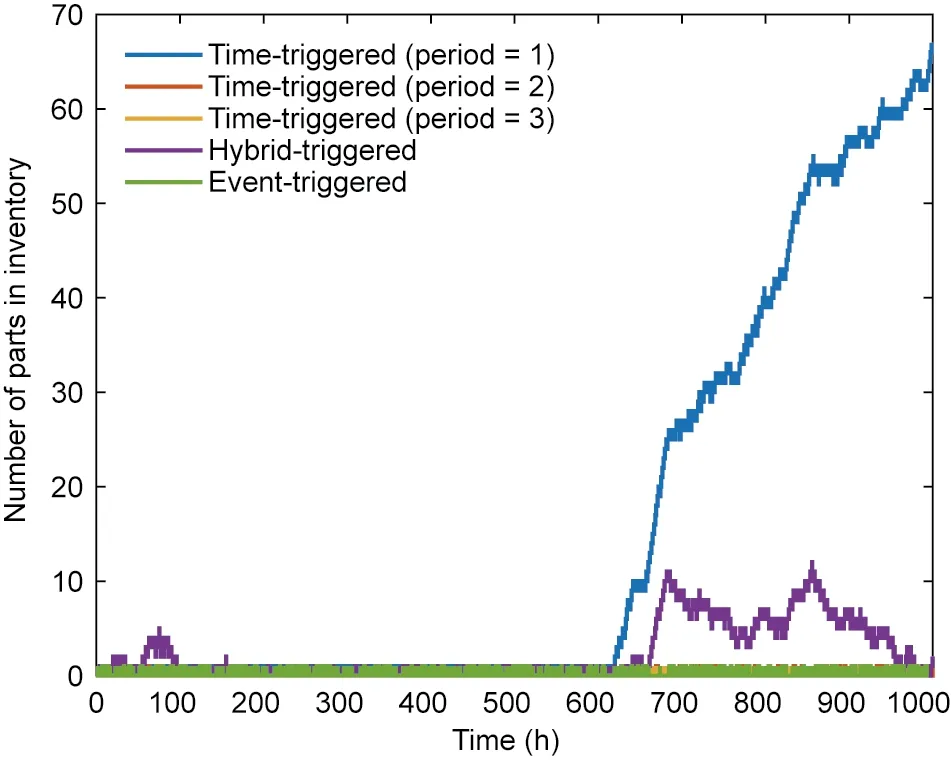
Fig. 10. A comparison of the numbers of parts in the inventory between different production modes.
Fig. 11 shows a comparison of the results for the number of products in the inventory over time between the five productiontriggering models. It is shown that the time-triggered (period = 2,period = 3) models, the hybrid-triggered model, and the eventtriggered model perform excellently, although the time-triggered(period = 2) model exhibits small waves from t = 650 h to t = 950 h. Compared with the other four models, the performance of the time-triggered(period=1)model is very poor in terms of the product inventory.The number of products in the inventory of the time-triggered (period=1) model reaches its maximum inventory capacity value of 100 (as defined in Section 4.1) at time t = 600.
4.3. Discussion
The simulation results illustrate that the production period is a key factor in the time-triggered production strategies. In such strategies, order arrivals are not considered when the enterprises make production plans. In this research, the order arrival rate r in the simulation models is set as 0.5. Hence, the expectation of the number of order arrivals per unit time is 1/r=2.When the periods τpartand τprodof the time-triggered strategies are set to 2(e.g.,Model-2), the model performs well in terms of both the order delivery time and the inventory occupancy,as shown in the simulation results.When τpart=1 and τprod=1(e.g.,Model-1),the timetriggered model performs well in terms of the order delivery time,but the part inventory occupancy and product inventory occupancy are much higher than those of the other strategies,as shown in Figs. 10 and 11. When τpart= 3 and τprod= 3, as in Model-3, the time-triggered model exhibits a good performance in terms of the inventory occupancy, but the number of delivered orders during the same time is much less than those of the other strategies, as shown in Figs. 8 and 9, meaning that the model exhibits a longer than average order delivery time.
The event-triggered production strategy has the lowest inventory occupancy, which leads to the lowest inventory costs, as shown in Figs. 10 and 11. However, the event-triggered strategy has a much longer order delivery time than the time-triggered strategies (period = 1, period = 2) and the hybrid-triggered strategy, although it is slightly better than the time-triggered strategy (period = 3) as shown in Figs. 8 and 9.
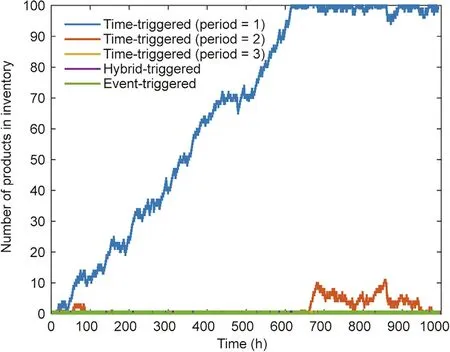
Fig. 11. A comparison of the numbers of products in the inventory between different production modes.
The hybrid-triggered strategy yields satisfactory order delivery times.Although there are some local fluctuations,the strategy generally performs satisfactorily. Moreover, the hybrid-triggered strategy performs well in terms of both the part inventory occupancy and the product inventory occupancy. Especially in terms of the product inventory, the hybrid-triggered strategy exhibits the best performance, as shown by Fig. 11. Therefore, the hybrid-triggered production strategy is a wise choice for balancing the order delivery time and the inventory costs.
In summary, if the order arrival times align with the Poisson distribution Pois(r), then manufacturing enterprises in a manufacturing service network should choose the hybrid-triggered strategy or a time-triggered strategy with a period τ=1/r because these two production strategies perform well in terms of both the order delivery time and the inventory costs. Applying either of these two strategies provides a good balance between the order delivery time and the production costs.Both time-triggered strategies with a period τ > 1/r and the event-triggered strategy yield low inventory costs but have a long order delivery time, which results in lower customer satisfaction. The time-triggered strategies with a period τ < 1/r show good performance in terms of short-order delivery time,but occupy a great deal of the inventory during production processes.
5. Conclusions
Focusing on the production-triggering problem in a dynamic collaborative manufacturing environment, we proposed three types of production-triggering strategies for manufacturing enterprises under randomly arriving orders: time-triggered, eventtriggered, and hybrid-triggered strategies. Simulation models of these three production-triggering strategies were built and simulated in order to investigate their performance in terms of order delivery time and inventory costs. In addition, for the timetriggered and hybrid-triggered strategies, we changed the period in order to study the effect of the period on system performance.The simulation results showed that:①The hybrid-triggered strategy and the time-triggered strategy with a period τ= 1/r show better performance in terms of both the order delivery time and the inventory costs than the other strategies; ②the time-triggered strategies with a period τ > 1/r and the event-triggered strategy have lower inventory costs but a longer order delivery time; and③the time-triggered strategies with a period τ<1/r exhibit better performance in terms of order delivery time but poor performance in terms of inventory costs.
One possible future work is to design more detailed production models in terms of production processes and mapping relationships between part types and product types. Another direction is to study more complex manufacturing service networks, such as cloud manufacturing and social manufacturing environments.
Acknowledgement
This work is supported by the National Key R&D Program of China (2018YFB1701600), and the National Natural Science Foundation of China (61873014).
Compliance with ethics guidelines
Longfei Zhou,Lin Zhang,and Yajun Fang declare that they have no conflict of interest or financial conflicts to disclose.
- Engineering的其它文章
- Artificial Intelligence Cracks a 50-Year-Old Grand Challenge in Biology
- Large-Scale Membrane Bioreactors for Industrial Wastewater Treatment in China: Technical and Economic Features, Driving Forces, and Perspectives
- Hydrogen Energy: A Global Trend and China’s Strategy
- The Vision of France, Germany, and the European Union on Future Hydrogen Energy Research and Innovation
- Insight from Japan’s Hydrogen Strategy and Activities
- Humans Are Not Machines—Anthropocentric Human–Machine Symbiosis for Ultra-Flexible Smart Manufacturing

